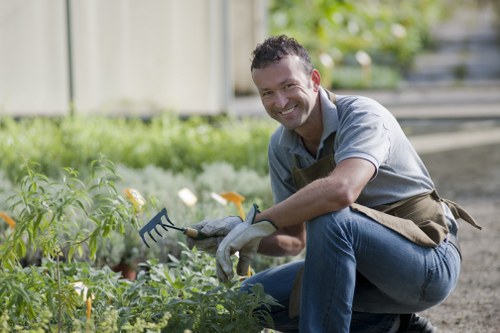Comprehensive Guide to Garden Maintenance in Coney Hall

Introduction to Garden Maintenance
Maintaining a beautiful garden in Coney Hall requires consistent care and attention. Whether you're an experienced gardener or a novice, understanding the fundamentals of garden upkeep is essential for achieving a lush and vibrant outdoor space.
Garden maintenance encompasses a variety of tasks, from planting and pruning to weeding and fertilizing. By adhering to a regular maintenance schedule, you can ensure that your garden remains healthy and visually appealing throughout the year.
In this guide, we'll explore the key aspects of garden maintenance specific to the Coney Hall area, taking into account the local climate, soil conditions, and native plant species.

Understanding the Coney Hall Climate
Local Weather Patterns
Coney Hall experiences a temperate climate with distinct seasons, which significantly influences garden maintenance practices. Summers are warm and sunny, while winters can be cold with occasional frost. Spring and autumn bring moderate temperatures and increased rainfall.
Understanding these weather patterns is crucial for planning your garden activities. For instance, planting should be timed to avoid extreme weather, and protective measures should be taken during harsh conditions.
Additionally, local microclimates within Coney Hall, such as shaded areas or sun-exposed spots, can affect plant growth and maintenance needs.

Soil Preparation and Health
Testing and Improving Soil Quality
The foundation of a thriving garden lies in healthy soil. In Coney Hall, soils can vary widely, so it's essential to conduct a soil test to determine pH levels, nutrient content, and texture.
Based on the test results, you may need to amend the soil to improve its structure and fertility. Common amendments include compost, manure, and organic fertilizers, which enhance nutrient availability and promote beneficial microbial activity.
Regularly incorporating organic matter into your soil not only enriches it but also aids in moisture retention and drainage, creating an optimal environment for plant roots.

Plant Selection and Care
Choosing the Right Plants for Coney Hall
Selecting plants that are well-suited to the Coney Hall climate and soil conditions is vital for minimizing maintenance efforts and ensuring garden success.
Consider native species, as they are adapted to the local environment and require less water and care. Additionally, a mix of perennials and annuals can provide year-round interest and variety.
When planting, pay attention to spacing and placement to allow for proper airflow and sunlight exposure, reducing the risk of diseases and promoting vigorous growth.
Planting Techniques
Proper planting techniques are essential for the health and longevity of your plants. Follow guidelines for depth, spacing, and watering to establish strong root systems.
Mulching
Applying mulch around your plants helps conserve moisture, suppress weeds, and regulate soil temperature. Organic mulches, such as bark or straw, also decompose over time, enriching the soil.

Pruning and Trimming
Maintaining Plant Shape and Health
Regular pruning and trimming are essential tasks in garden maintenance. They help maintain the desired shape of plants, encourage healthy growth, and prevent overgrowth that can lead to pest infestations.
Use the appropriate tools for each type of plant, and always follow best practices to avoid damaging stems or branches. Pruning at the right time of year, often during the dormant season, can enhance plant resilience and flowering.
Deadheading Flowers
Removing spent blooms, or deadheading, stimulates plants to produce more flowers and prevents seed formation that can sap energy from the plant.
Shaping Hedges and Bushes
Regularly trimming hedges and bushes helps maintain their shape and density. This practice also promotes healthy growth and improves the overall appearance of your garden.
Weed Control Strategies
Preventing and Managing Weeds
Weeds compete with your garden plants for nutrients, water, and sunlight. Effective weed control is a crucial aspect of garden maintenance in Coney Hall.
Implement a combination of manual removal, mulching, and the use of organic or chemical herbicides to manage weed growth. Regular monitoring and prompt action can prevent weeds from becoming a significant problem.
- Manual Removal: Hand-pulling weeds is effective for small infestations and ensures that the entire root is removed.
- Mulching: Applying a thick layer of mulch can suppress weed germination by blocking light.
- Herbicides: Use targeted, environmentally friendly herbicides to control persistent weeds without harming desirable plants.
Preventative Measures
Adopt preventative measures such as landscape fabric and proper garden planning to reduce weed establishment. By creating barriers and selecting dense, ground-cover plants, you can minimize the space available for weeds to grow.
Seasonal Weed Control
Different weeds thrive in different seasons. Tailor your weed control strategies to address seasonal variations, ensuring year-round garden health.
Irrigation and Water Management
Efficient Watering Practices
Proper irrigation is vital for maintaining a healthy garden in Coney Hall. Efficient watering practices conserve water and ensure that plants receive the appropriate amount of moisture.
Consider installing a drip irrigation system, which delivers water directly to the plant roots, reducing evaporation and runoff. Scheduling watering during the early morning or late evening can further improve efficiency.
Monitor soil moisture levels regularly and adjust your watering schedule based on weather conditions and plant needs.
- Drip Irrigation: Provides targeted watering, minimizing waste.
- Rain Barrels: Collect rainwater for use during dry periods.
- Soaker Hoses: Distribute water evenly across garden beds.
Water Conservation Tips
Implement water conservation techniques such as mulching, using native drought-resistant plants, and improving soil structure to enhance water retention.
Automated Systems
Automated irrigation systems with timers and moisture sensors can optimize water use and reduce manual effort in garden maintenance.
Fertilization and Soil Nutrition
Feeding Your Garden
Providing your plants with essential nutrients through regular fertilization ensures robust growth and vibrant blooms. In Coney Hall, soil fertility can vary, so a soil test is recommended to identify specific nutrient deficiencies.
Choose fertilizers that match your garden's needs, whether organic options like compost and manure or synthetic products tailored to particular plant requirements.
Apply fertilizers according to manufacturer instructions and avoid over-fertilization, which can harm plants and the environment.
- Organic Fertilizers: Enhance soil health and promote sustainable growth.
- Synthetic Fertilizers: Provide targeted nutrient boosts for specific plant needs.
- Slow-Release Options: Ensure a steady supply of nutrients over time.
Soil Amendment Practices
Incorporate soil amendments such as lime or sulfur to adjust pH levels, ensuring optimal nutrient uptake by plants.
Composting
Creating your own compost recycles garden waste into valuable soil conditioner, enriching your garden's nutrient content and improving soil structure.
Pest and Disease Management
Identifying Common Pests
Garden pests can pose significant threats to plant health and productivity. In Coney Hall, common pests include aphids, slugs, and caterpillars.
Early identification and intervention are crucial for managing pest populations. Regularly inspect your plants for signs of infestation, such as damaged leaves, discoloration, or the presence of insects.
Implement integrated pest management (IPM) strategies that combine biological, cultural, and chemical controls to minimize pest damage effectively.
- Biological Controls: Introduce beneficial insects like ladybugs that prey on common garden pests.
- Cultural Controls: Practice crop rotation and proper sanitation to disrupt pest life cycles.
- Chemical Controls: Use eco-friendly pesticides when necessary, following all safety guidelines.
Preventing Plant Diseases
Fungal and bacterial diseases can weaken or kill plants if not addressed promptly. Maintain good garden hygiene by removing diseased plant material and ensuring adequate air circulation.
Natural Remedies
Utilize natural remedies such as neem oil or garlic spray to combat plant diseases without harming beneficial organisms.
Seasonal Garden Maintenance
Spring Maintenance Tasks
Spring is a time of renewal in the garden. Start by cleaning up any debris accumulated over winter, pruning dead branches, and preparing beds for new plantings.
Fertilize perennial plants and sow seeds for annuals to ensure a vibrant display during the warmer months.
Summer Care
Focus on watering, weeding, and pest control during the summer. Regularly check plants for signs of stress and adjust care routines as needed.
Autumn Preparation
As the growing season winds down, begin to prepare your garden for winter by mulching, planting cover crops, and protecting sensitive plants from frost.
Tools and Equipment for Garden Maintenance
Essential Gardening Tools
Having the right tools is essential for efficient garden maintenance. Invest in quality equipment such as pruners, hoes, spades, and watering systems to make your tasks easier and more effective.
- Pruners: For trimming and shaping plants.
- Hoes: Ideal for weeding and cultivating soil.
- Spades: Useful for digging and planting.
- Watering Systems: Enhance irrigation efficiency.
Maintenance of Tools
Regularly clean and sharpen your tools to ensure their longevity and performance. Proper maintenance prevents rust and extends the life of your gardening equipment.
Storage Solutions
Store tools in a dry, organized space to protect them from the elements and make them easily accessible when needed.
Landscape Design and Aesthetics
Creating an Attractive Garden Layout
Thoughtful landscape design enhances the beauty and functionality of your garden. Plan your garden layout by considering factors such as plant color schemes, height variations, and focal points.
Incorporate elements like pathways, seating areas, and decorative features to add interest and usability to your outdoor space.
- Pathways: Guide visitors through your garden and prevent soil compaction.
- Seating Areas: Provide spaces for relaxation and enjoyment.
- Focal Points: Highlight specific plants or structures to draw attention.
Color and Texture Coordination
Balance colors and textures by mixing different plant varieties to create visual harmony and depth in your garden design.
Seasonal Interest
Select plants that offer seasonal interest, ensuring your garden remains attractive throughout the year with blooms, foliage changes, and structural features.
Eco-Friendly Garden Practices
Sustainable Gardening Techniques
Adopting eco-friendly practices in your garden not only benefits the environment but also promotes healthier plant growth. Implement techniques such as composting, rainwater harvesting, and using organic fertilizers.
Encourage biodiversity by planting a variety of species, including pollinator-friendly flowers, to support local wildlife and create a balanced ecosystem.
Reducing Chemical Use
Minimize the use of chemical pesticides and fertilizers by opting for natural alternatives and integrated pest management strategies.
Conservation Practices
Conserve water and energy by utilizing efficient irrigation systems and selecting drought-tolerant plants that require less maintenance.
Hiring Professional Garden Maintenance Services
Benefits of Professional Help
While DIY garden maintenance can be fulfilling, hiring professional services in Coney Hall can save time and ensure expert care for your garden.
Professional gardeners bring specialized knowledge, access to high-quality tools, and the ability to handle complex maintenance tasks efficiently.
- Expertise: Professionals understand the specific needs of different plants and soil conditions.
- Time-Saving: Outsourcing maintenance frees up your schedule for other activities.
- Consistent Results: Regular professional care ensures your garden remains in optimal condition.
Choosing the Right Service
When selecting a garden maintenance service in Coney Hall, consider factors such as experience, reputation, and the range of services offered to find a provider that meets your specific needs.
Customized Maintenance Plans
Many professional services offer customized maintenance plans tailored to the unique requirements of your garden, ensuring personalized and effective care.
Conclusion
Effective garden maintenance in Coney Hall involves a combination of proper planning, regular care, and the use of appropriate techniques and tools. By understanding the local climate, selecting suitable plants, and implementing sustainable practices, you can cultivate a thriving and beautiful garden.
Whether you choose to maintain your garden independently or enlist the help of professionals, consistent effort and attention to detail will reward you with a vibrant and enjoyable outdoor space.
Contact us today to learn more about how you can enhance your garden maintenance routine in Coney Hall and achieve the garden of your dreams.